![Tiktok monitoring The Ultimate Guide [+ Best Tools to Use]](https://competitors.app/wp-content/uploads/2024/01/tiktok-monitoring-The-Ultimate-Guide-Best-Tools-to-Use-1.png)
TikTok has become more than a platform for entertainment; it’s now a key channel for brand awareness and engagement. Understanding TikTok monitoring is essential for any business trying to increase awareness among any age group. More specifically Tik Tok has become really popular here are some interesting statistics about its growth:
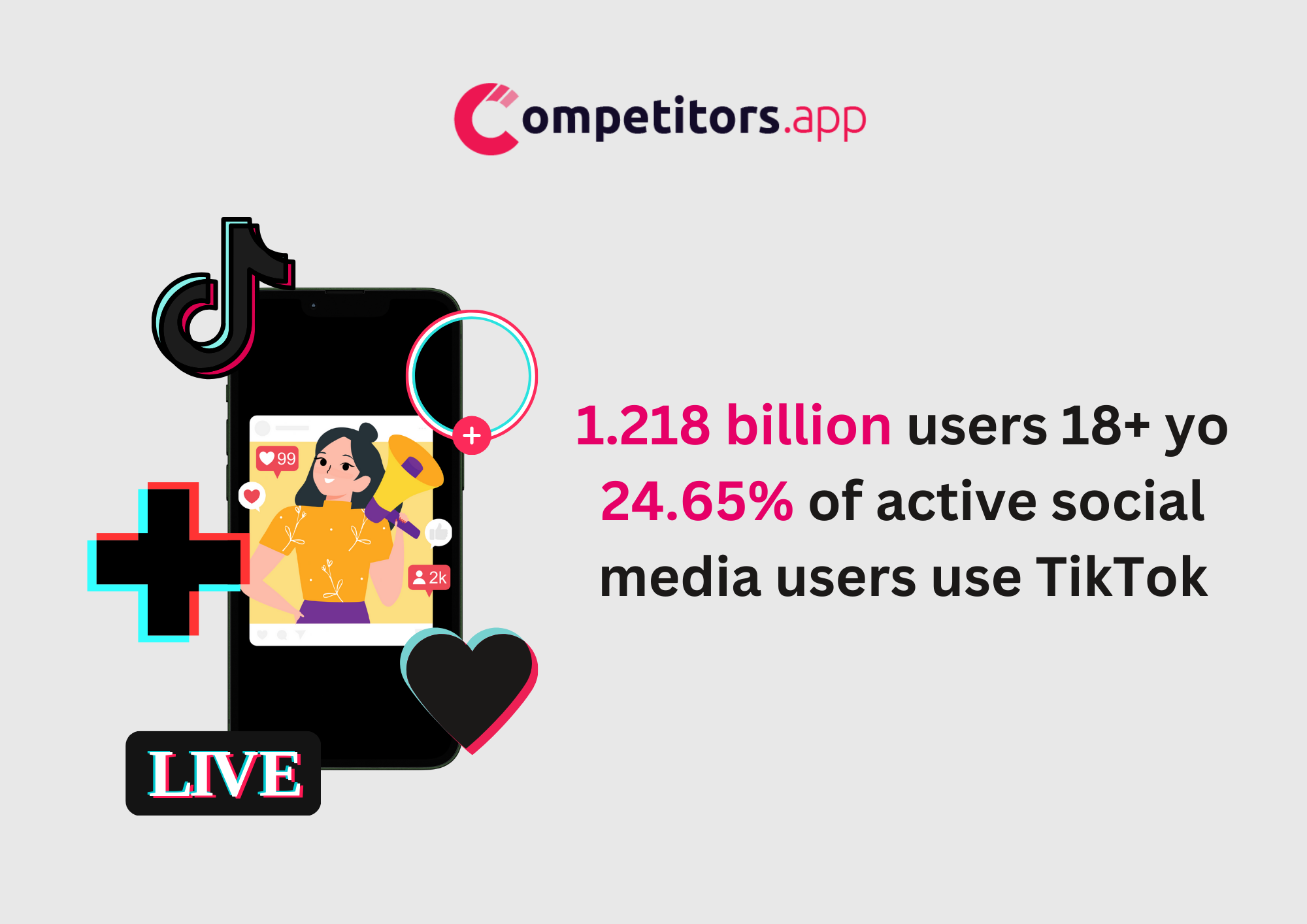
This guide will explore the ins and outs of TikTok monitoring, emphasising its importance and how to do it effectively and why monitoring tik tok allows you to unveil a vast majority of data. We’ll also review the best TikTok monitoring tools available in 2024. This guide is designed to provide valuable insights for experienced social media managers and newcomers to the platform, offering practical tips and strategies to enhance your brand’s presence on TikTok.
Understanding the role of social listening in today’s marketing strategies, especially on platforms like TikTok, is crucial for businesses. It involves more than just tracking brand mentions or hashtags. It’s about comprehensively analysing audience interactions, their conversations, and the content they engage with. By effectively monitoring TikTok, businesses can tap into a wealth of information about consumer behaviours, preferences, and emerging trends. This insight is invaluable for crafting content that resonates with your audience, responding to their needs in real time, and building a stronger, more informed connection with them. Additionally, social listening helps in identifying potential areas for improvement, tracking the effectiveness of marketing campaigns, and staying ahead of competitors by understanding what works and what doesn’t in the ever-evolving TikTok ecosystem.
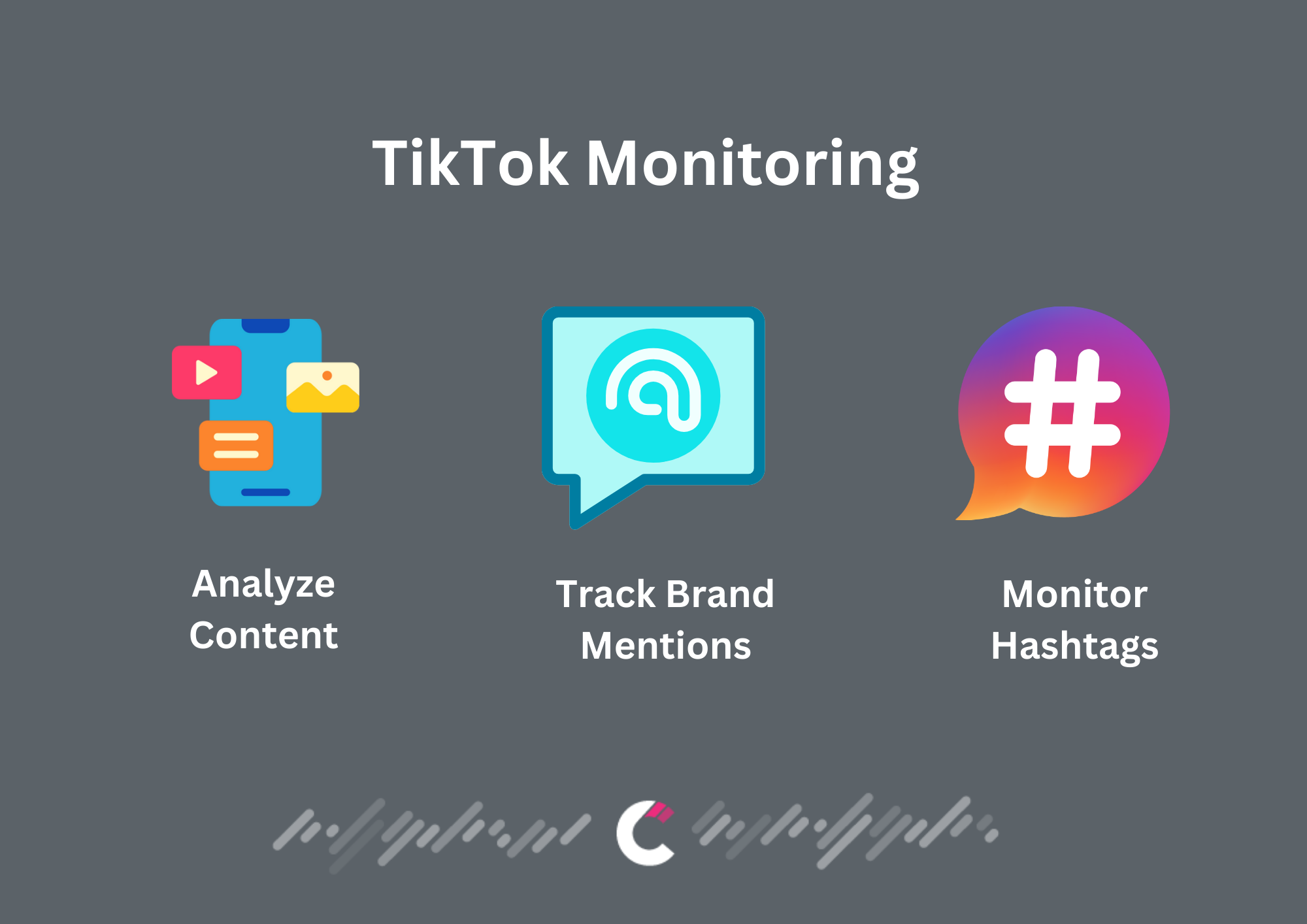
TikTok monitoring is a process that involves more than just observing what’s happening on the platform. It’s about systematically analysing TikTok content to extract meaningful insights for your brand. This includes tracking your brand’s mentions, monitoring hashtags related to your industry, understanding the performance of your marketing campaigns, and keeping an eye on competitor activities. It also involves listening to what users are saying about your brand and industry, which can provide valuable feedback.
TikTok monitoring tools make this process easier by aggregating data and providing analytics that help you understand the impact of your TikTok presence. In essence, it’s a comprehensive approach to gauge your brand’s performance and audience engagement on one of the most popular social media platforms today.

Engaging in TikTok monitoring brings a multitude of benefits for brands.
For social media managers, TikTok presents a unique and valuable opportunity. First, the platform’s vast and diverse user base allows brands to reach a wide array of audiences, particularly younger demographics that are highly active online. By engaging on TikTok, brands can connect with these audiences in a space where they spend a significant amount of their time. Furthermore, TikTok’s algorithm favours creative and authentic content, enabling even smaller brands to achieve viral success with the right strategy. This means that social media managers can experiment with different types of content to see what resonates best with their audience, offering a level of flexibility and creativity not always possible on other platforms. Additionally, TikTok’s format encourages user interaction and engagement, which can help brands build a more personal and interactive relationship with their audience. In essence, for social media managers, TikTok is not just another platform to manage; it’s a dynamic and engaging space to connect with audiences, build brand awareness, and drive engagement in a way that other platforms might not offer.

Monitoring TikTok for your brand involves several key steps:
When monitoring TikTok for your brand, focusing on key metrics is essential to gauge effectiveness. These metrics include:
1. Engagement Rate: This is a critical metric that measures how actively your audience interacts with your content. It includes likes, comments, shares, and video views. A high engagement rate usually indicates content that resonates well with your audience.
2. Follower Growth: Tracking follower growth helps you understand if your content is attracting new audiences. A steady increase in followers suggests your TikTok strategy is working.
3. Hashtag Performance: Hashtags are integral to TikTok. Monitoring how your branded hashtags perform can provide insights into your campaign’s reach and engagement.
4. Video View Trends: Observing which videos gain more views can inform you about the type of content your audience prefers. This helps in tailoring future content to match audience interests.
5. Audience Demographics and Behaviour: Understanding who your audience is (age, location, interests) and when they are most active can help in optimising post timings and content style.
6. Sentiment Analysis: Gauging the sentiment of the comments and messages you receive can help assess the public perception of your brand.
Regularly tracking these metrics will provide a comprehensive view of your TikTok strategy’s performance and areas for improvement.

Effectively managing both positive and negative comments on TikTok is crucial for maintaining a healthy brand image. For positive comments, it’s important to engage with them. Acknowledge and respond to these comments to build a stronger rapport with your audience. Showing appreciation for positive feedback encourages more of such interactions and can foster a loyal community.

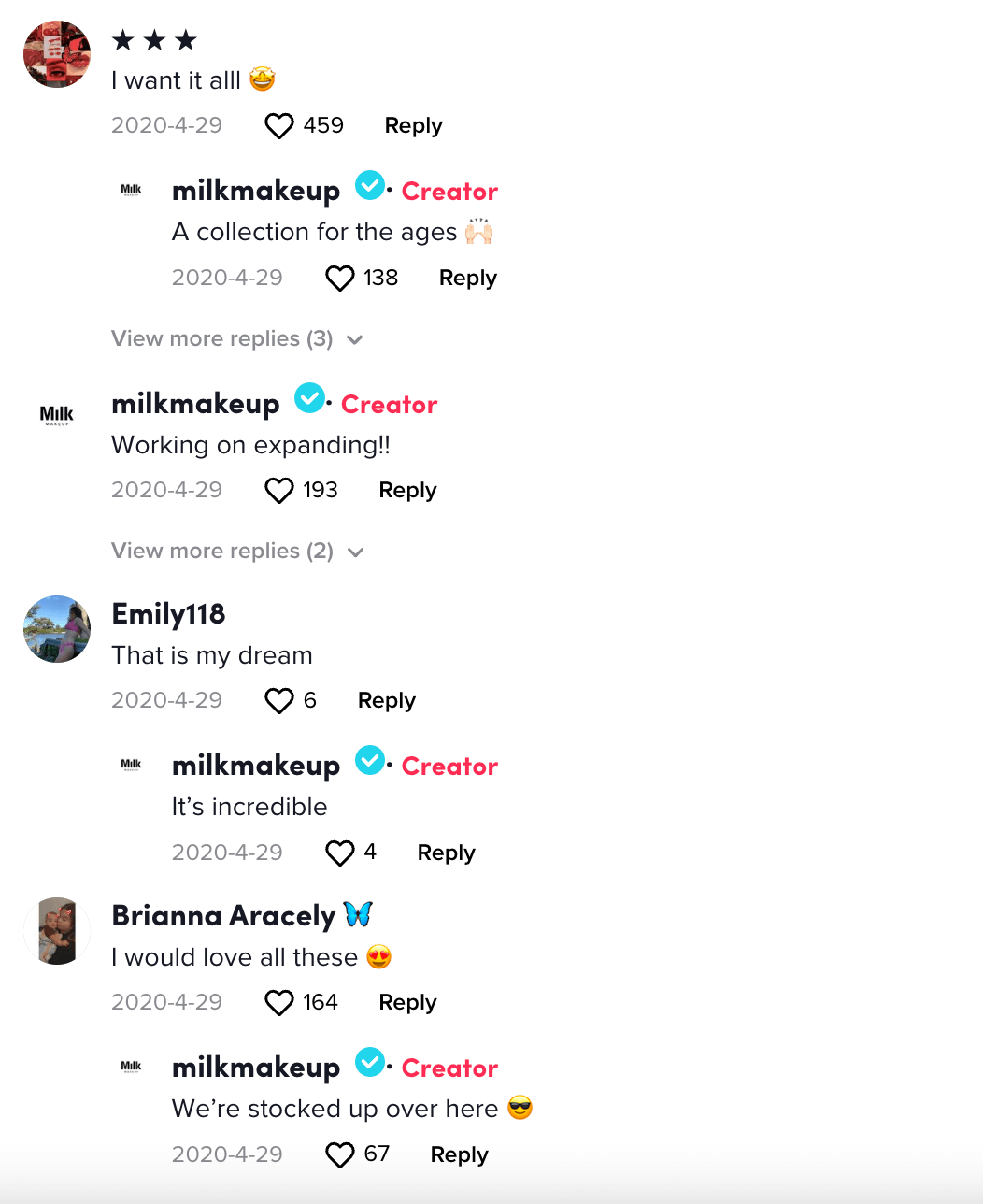
On the other hand, negative comments should not be ignored. Address them promptly and professionally. If the criticism is constructive, acknowledge the issue and explain any steps being taken to address it. This transparency can turn a negative situation into an opportunity to demonstrate your brand’s commitment to customer satisfaction. In cases where comments are inappropriate or irrelevant, deleting them or blocking users may be necessary to maintain a positive Community environment.

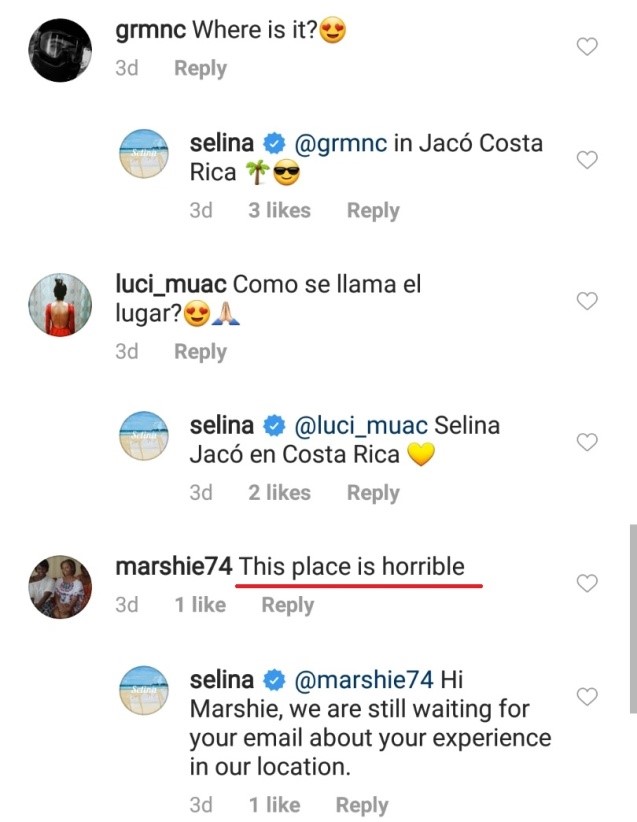
Monitoring comments also provides insights into customer sentiment and emerging trends or issues with your products or services. This feedback can be invaluable for making improvements or developing new strategies.
Remember, how a brand handles social media comments can significantly impact its reputation, so it’s important to manage this aspect of TikTok monitoring with care and attention. Brands that answer well and give creative answers will benefit enormously.
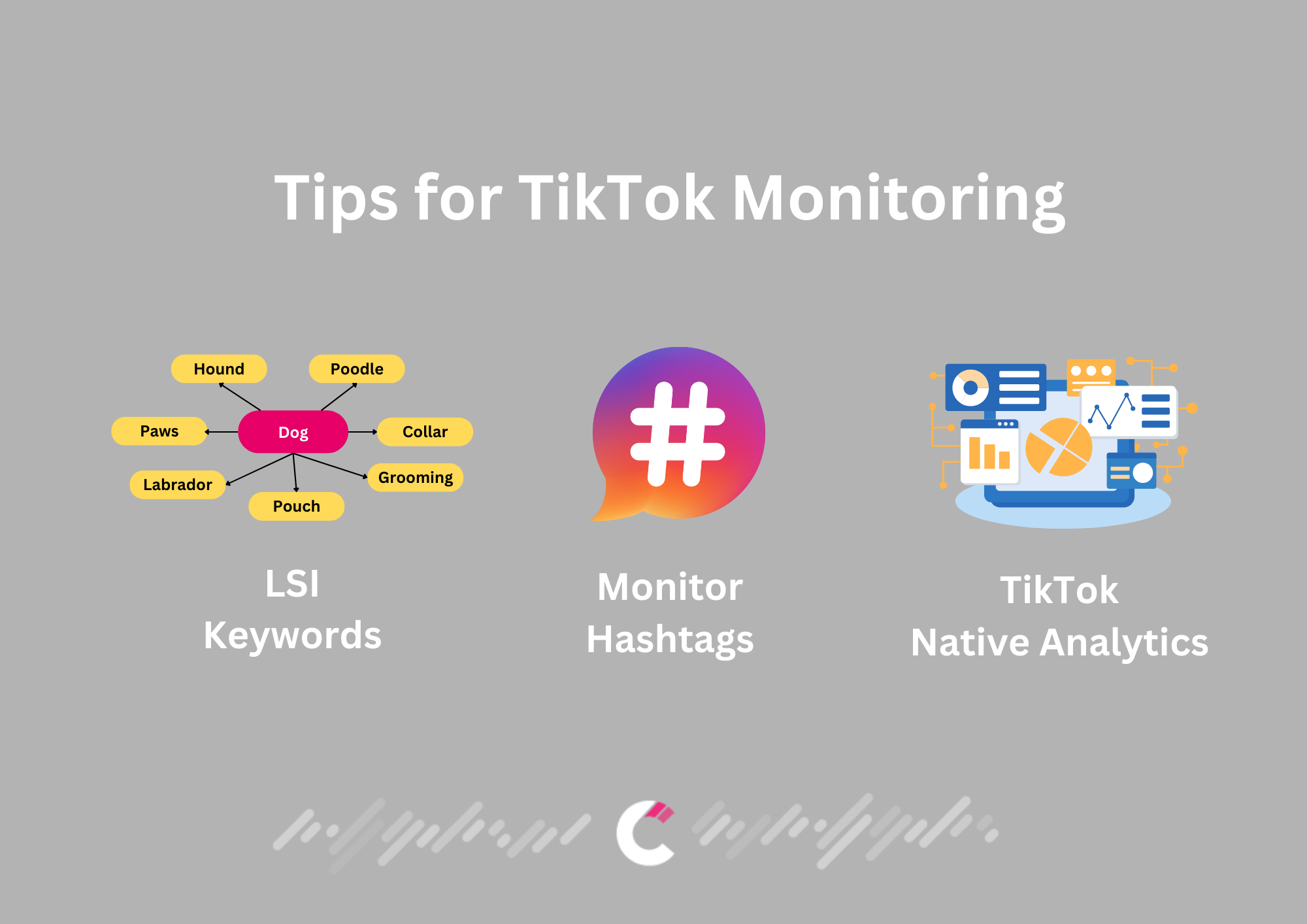
Latent Semantic Indexing (LSI) keywords play a significant role in enhancing TikTok monitoring. LSI keywords are basically words and phrases that are closely related to your main topic or keywords. They help in creating a broader net to capture more relevant content on TikTok. For instance, if your main keyword is “fitness training,” LSI keywords could include “workout routines,” “health tips,” or “exercise equipment.”
The idea behind using LSI keywords in TikTok monitoring is that people might not always use your exact main keyword when talking about your brand or related topics. By including these related terms in your monitoring, you can find more conversations, videos, and trends that are relevant but might have been missed otherwise. This gives you a fuller picture of the online discussion around your industry, helping you understand your audience better and refine your content strategy on TikTok.
To effectively use LSI keywords in TikTok monitoring:
1. Identify Relevant LSI Keywords: Start by researching keywords related to your primary TikTok topics. Tools like Google Keyword Planner or even TikTok’s search function can help you find related phrases that your audience might be using.
2. Monitor Conversations Using LSI Keywords: Incorporate these LSI keywords into your monitoring tools to track broader conversations around your brand and industry. This can uncover content and discussions that you might miss with only primary keywords.
3. Analyse Content Themes: Use the insights from LSI keyword monitoring to understand the themes and topics that resonate with your audience. This can inform your content strategy, making it more aligned with user interests and search behaviour.
4. Optimise Your Content: Integrate LSI keywords into your TikTok content where relevant. This can help improve the visibility of your posts and ensure they reach a wider, yet targeted, audience.
By leveraging LSI keywords, you can gain deeper insights into audience interests and trends, ensuring that your TikTok monitoring and content strategy remains comprehensive and effective.
Hashtag monitoring is a key aspect of TikTok monitoring. It involves tracking specific hashtags relevant to your brand, industry, or marketing campaigns. This strategy helps in understanding how your content is performing and how it’s being received by the TikTok community. Here’s how to effectively implement hashtag monitoring:
1. Identify Relevant Hashtags: Start by identifying hashtags that are commonly used in your industry, as well as those used by competitors and influencers. Don’t forget to include branded hashtags unique to your company.
2. Track Hashtag Performance: Use TikTok’s analytics tools or third-party monitoring tools to track the performance of these hashtags. Look at metrics like the number of posts, views, engagement, and the type of content associated with these hashtags.
3. Engage with the Community: When users include your branded hashtags in their posts, engage with them. This could be through likes, comments, or even sharing their content (with permission). This not only boosts engagement but also encourages more users to use your hashtags.
4. Adjust Content Strategy Based on Insights: Analyse the content associated with these hashtags to understand what works. Use these insights to inform your content creation, ensuring it aligns with trends and audience preferences.
5. Monitor Trends and Emerging Hashtags: Stay updated with new and trending hashtags. Participating in these trends can increase your brand’s visibility and relevance on the platform.
Hashtag monitoring is a dynamic process. It requires regular updates and adjustments to your strategy to stay relevant and effectively engage with the TikTok community.

To truly excel in TikTok marketing, understanding and mastering TikTok Analytics is key. TikTok Analytics provides a wealth of data that can help you refine your marketing strategies and understand your audience better. Here’s how you can make the most of it:
1. Accessing TikTok Analytics: First, ensure you have a Pro Account, as this gives you access to the analytics dashboard. This dashboard offers a comprehensive overview of your profile’s performance, including video views, follower growth, and user engagement.
2. Understanding the Dashboard: The dashboard is divided into three main sections: Overview, Content, and Followers. The Overview section gives a snapshot of your account’s performance. The Content section provides detailed insights into how individual posts are performing. The Followers section offers demographic information about your audience, such as gender, location, and activity times.
3. Analysing Engagement Metrics: Pay close attention to metrics like watch time, shares, comments, and likes. These indicate how engaging your content is. Videos with higher engagement are more likely to appear on users’ For You pages.
4. Tracking Follower Trends: Monitor how your follower count changes in relation to content posting. This can help you understand what content drives audience growth and engagement.
5. Content Analysis: Use the Content tab to see which videos performed best over the last 7 to 28 days. Analysing your top-performing content can provide insights into what your audience prefers.
6. Audience Insights: Understanding your audience’s demographics and active hours can help you tailor your content and posting schedule to maximise engagement.
7. Utilising Data for Strategy: Regularly review this data to inform your content strategy. Experiment with different types of content, posting times, and hashtags based on your findings.
8. Competitor Analysis: Keeping an eye on your competitors’ performance metrics can provide valuable insights and help you identify opportunities to differentiate your brand.7. Competitor Analysis: Keeping an eye on your competitors’ performance metrics can provide valuable insights and help you identify opportunities to differentiate your brand.
By effectively utilising TikTok Analytics, you can gain a deeper understanding of your audience and what content performs best, enabling you to create a more targeted and successful TikTok strategy.

As of 2024, a few TikTok monitoring tools have distinguished themselves in the market. When choosing a tool, it’s important to consider aspects like analytics depth, user interface, and budget. Here are some noteworthy tools:
Brand name | Key features | Prices |
– Key Features: Efficient competitor tracking and analysis on social platforms and multiple other channels including TikTok. – Advantages: Keeps you informed about competitors’ strategies and helps in benchmarking. – Disadvantages: More focused on competitive analysis than on broader audience engagement metrics. | business–$19.99/Month/competitor Business Plus–$29.99/ Month/competitor Custom plan–speak with the team | |
2.Brand 24 | – Key Features: Offers extensive analytics, sentiment analysis, and competitor monitoring. – Advantages: Comprehensive insights into audience behaviour and content performance. – Disadvantages: Can be complex for beginners and has high prices. | Individual–$79/monthly Team–$149/monthly Pro–$199/monthly Enterprise–$399/monthly |
3. Storyclash | – Key Features: Specialises in tracking hashtag performance and analysing social media trends. – Advantages: Excellent for identifying emerging trends and popular content on TikTok. – Disadvantages: More focused on social trends and less on detailed individual account analytics. | Light–$799/month Profesional–$1599/month Enterprise–speak with the team (Offers free tools) |
4.Modash | – Key Features: Strong focus on influencer analytics and real-time monitoring. – Advantages: Ideal for businesses looking to collaborate with influencers on TikTok. – Disadvantages: Primarily tailored for influencer marketing rather than general brand monitoring. | Essentials–$99/monthly Performance–$249/monthly Advanced–$800/monthly Enterprise–Custom |
Each of these tools has unique strengths, so selecting one should be based on your specific monitoring goals, whether it’s tracking engagement, understanding audience sentiment, or keeping an eye on the competitive landscape.
For businesses or individuals on a tight budget, several free TikTok tracking tools offer basic monitoring capabilities. While these tools may not have all the advanced features of paid options, they can still provide valuable insights into your TikTok presence. Here are some free tools worth considering:
1. Competitors.app: Even though it’s primarily a paid tool, Competitors.app offers some basic free functionalities for tracking competitor activities on TikTok, which can be valuable for competitive analysis.
2. TikTok’s Native Analytics: Available for Pro accounts, it provides insights into profile views, follower growth, and content performance. It’s a good starting point for basic monitoring needs.
3. Social Blade: Offers basic tracking and analytics for various social media platforms, including TikTok. It’s useful for tracking follower trends and general account statistics.
4. Influencer Marketing Hub’s TikTok Analytics Tool: Provides insights into your TikTok account’s engagement rate and other performance metrics. It’s especially useful for evaluating the impact of specific posts.
5.Hootsuite: While primarily a social media management tool, Hootsuite offers some free features for monitoring TikTok, including scheduling posts and basic analytics.
Using these free tools, you can start monitoring your TikTok account, understanding your audience, and refining your content strategy without any upfront investment.
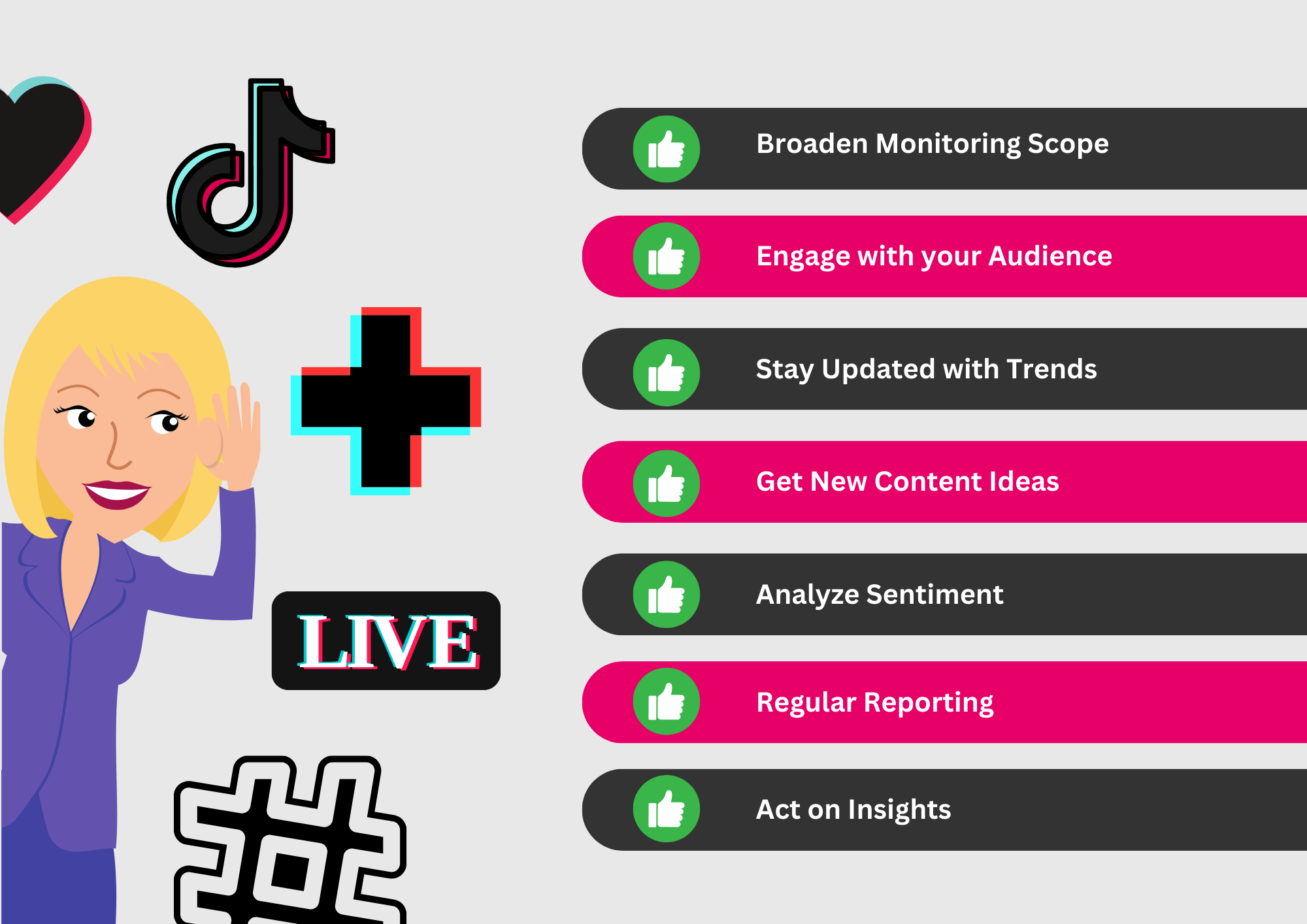
Effective TikTok social listening involves more than just monitoring your own account. It’s about understanding the wider conversation around your brand and industry on the platform. Here are some best practices to ensure your TikTok social listening is as effective as possible:
1. Broaden Your Monitoring Scope: Don’t limit yourself to tracking just your brand’s name or hashtags. Include industry-related terms, competitor names, and relevant trending topics to get a comprehensive view of the conversation.
2. Engage with Your Audience: Social listening is a two-way street. When you notice users talking about your brand or products, engage with them. Reply to their comments, answer their questions, and even share user-generated content (with permission). This builds community and shows that you value your audience’s input.
3. Stay Updated with Trends: TikTok is a trend-driven platform. Regularly check what’s trending and consider how you can authentically incorporate these trends into your content strategy.
4. Use Social Listening for Content Ideas: Analyse popular topics and discussions to inspire your content creation. This ensures that your content is relevant and resonates with your audience.
5. Analyse Sentiment: It’s important to gauge not just the volume of mentions but the sentiment behind them. Are people speaking positively or negatively about your brand? Use this insight to inform your marketing and product development strategies.
6. Regular Reporting: Establish a routine for reporting your findings. Regular reports can help track progress over time and identify patterns or shifts in audience sentiment and behaviour.
7. Act on Insights: Finally, use the insights gained from social listening to inform your TikTok strategy. This could mean adjusting your content, responding to a PR crisis, or even changing a product or service.
By following these best practices, you can ensure that your TikTok social listening efforts are thorough, responsive, and ultimately valuable to your overall marketing strategy.
Monitoring your competitors’ TikTok accounts is a strategic approach to gain insights and maintain a competitive edge in your market. Here’s how you can effectively monitor your competitors on TikTok:
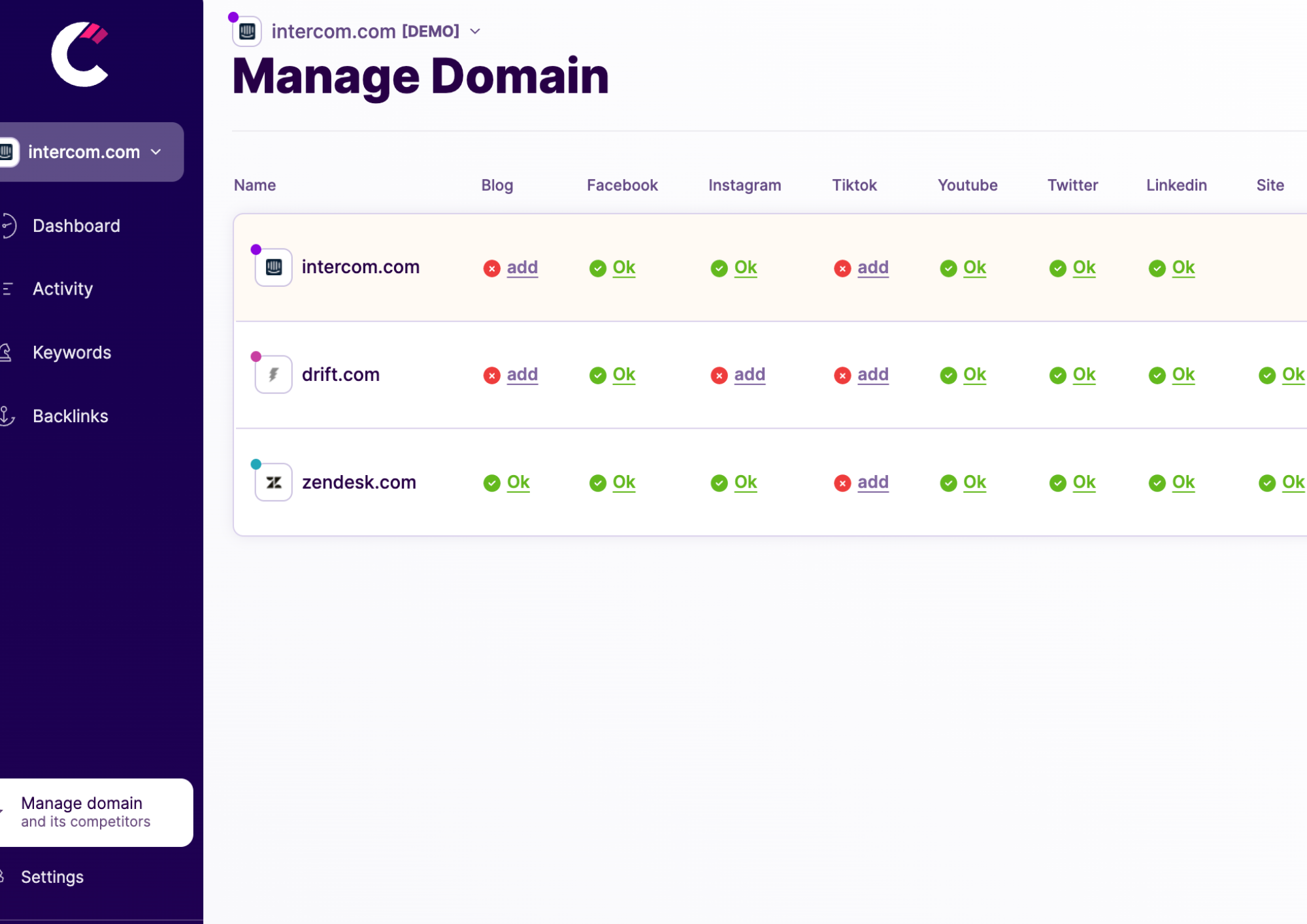
Start by pinpointing your main competitors on TikTok. These might be direct competitors within your industry or similar brands that target the same audience as you.

Once you've identified your main competitors, add them to the Competitors App. This tool allows you to track their TikTok activities in one place. You can see their latest posts, engagement metrics, and any changes in their content strategy, all of which can provide valuable insights.

Take a close look at the types of content your competitors are posting. Pay attention to their posting frequency, the themes they focus on, and their audience engagement methods. This analysis can offer valuable insights into strategies that resonate well with audiences you both share.

Keep tabs on how your competitors' follower count and engagement rates evolve. Utilising tools like Competitors.app or Social Blade can be instrumental in tracking these metrics over time, providing a clearer picture of their growth trajectory.

Monitor how audiences interact with your competitors’ content. Take note of the types of comments they receive and how the brand responds. This observation can shed light on their customer engagement strategy and may highlight areas you can improve upon in your approach.
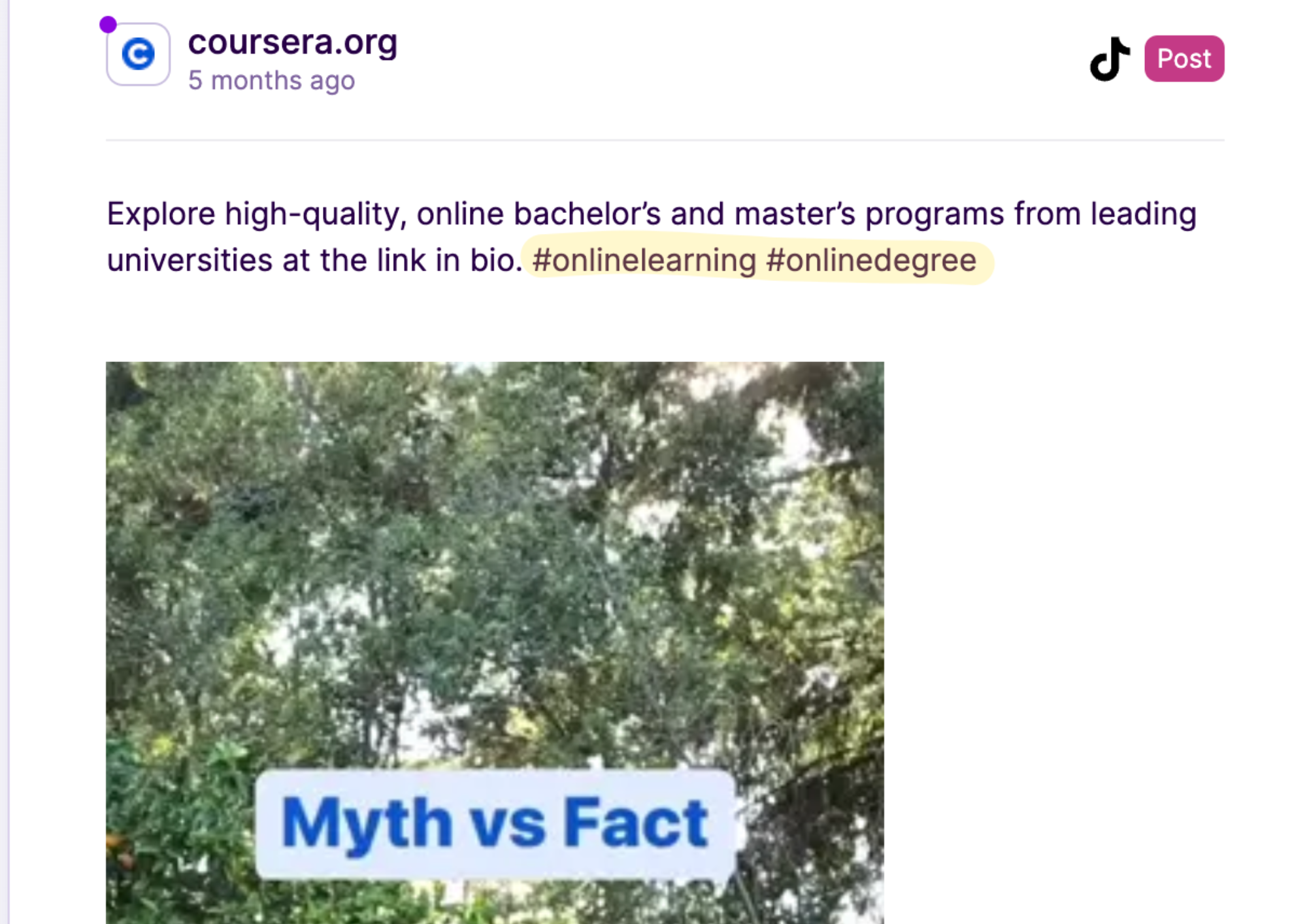
Analyse which hashtags your competitors are using and their effectiveness. Understanding their hashtag strategy can help in pinpointing trending hashtags within your industry.

If your competitors launch marketing campaigns or challenges on TikTok, observe their strategy and the audience's reaction. This can provide insights into what makes for successful campaign strategies on the platform.
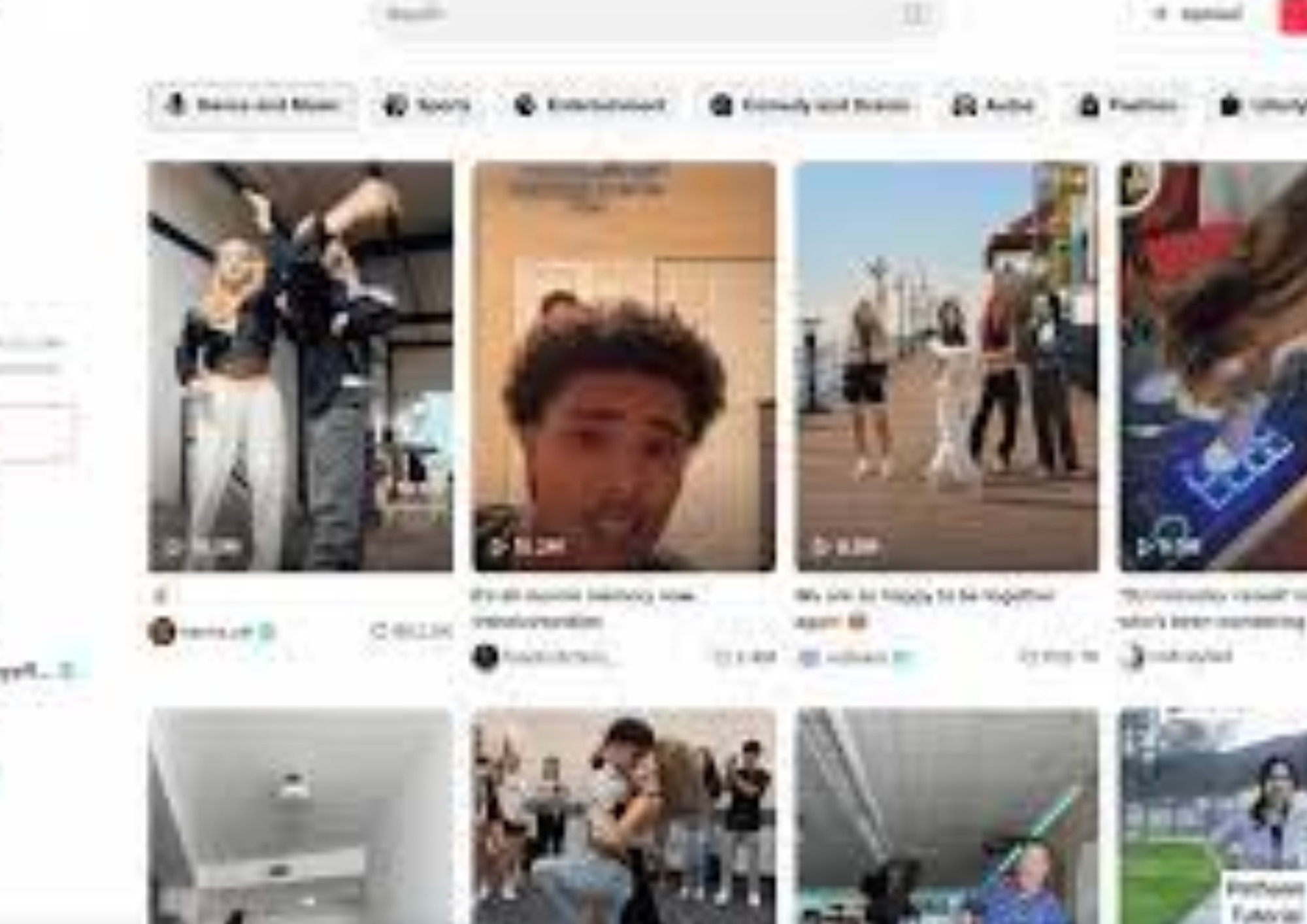
TikTok is a platform that’s continually evolving. Keep an eye on how your competitors adapt to and utilise new TikTok features or trends.
Remember, the objective of monitoring competitors is not to imitate them but to learn from both their successes and mistakes. By understanding their tactics, you can uncover opportunities to distinguish your brand and enhance your own TikTok strategy.
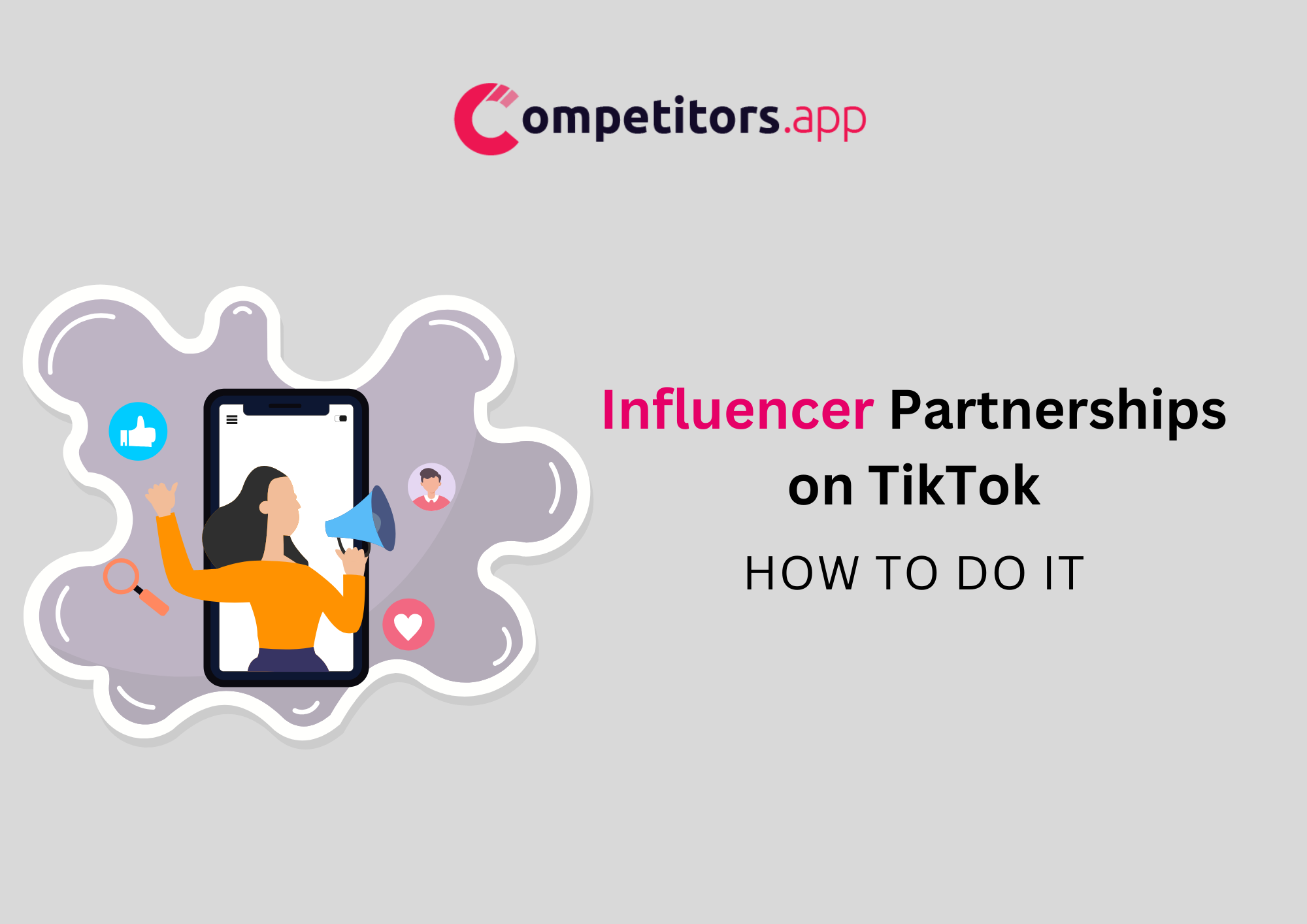
Influencer partnerships on TikTok can be a powerful tool for brands looking to expand their reach and connect with audiences in a more authentic way. Here’s how to approach influencer partnerships on TikTok:
1. Identify the Right Influencers: Look for influencers whose followers align with your target audience. It’s not just about follower count; relevance and engagement rates are key. Tools like Modash can be helpful in identifying potential influencers.
2. Analyse Their Content: Review the influencer’s content to ensure it aligns with your brand values and messaging. Their style, tone, and audience interaction should be a good fit for your brand.
3. Understand Their Audience: Use tools to analyse the influencer’s audience demographics and interests. This ensures that your message reaches the intended audience.
4. Set Clear Goals and Expectations: Define what you want to achieve with the partnership, whether it’s brand awareness, product launches, or driving sales. Communicate your goals and expectations clearly to the influencer.
5. Collaborative Content Planning: Work with the influencer to plan content that feels authentic to their style while effectively conveying your brand’s message. Authenticity is crucial on TikTok, and forced or overly promotional content can be off-putting to users.
6. Track Performance: Use TikTok analytics and other monitoring tools to track the performance of the influencer’s content. Metrics like engagement rates, reach, and conversion (if applicable) are important to evaluate the success of the partnership.
7. Build Long-Term Relationships: Consider building long-term relationships with influencers who are a good match for your brand. Consistent collaborations can lead to better brand recall among their audience.
Influencer partnerships, when done right, can significantly amplify your brand’s presence on TikTok, allowing you to leverage the influencers’ credibility and rapport with their followers.

Hashtag monitoring is a vital aspect of TikTok strategy, serving as a key tool for understanding trends, audience interests, and the performance of marketing campaigns. Here’s how to effectively utilise hashtag monitoring on TikTok:
1. Identify Relevant Hashtags: Start by identifying hashtags relevant to your brand and industry. This includes both popular and niche hashtags. You can find these by exploring TikTok, looking at competitors’ content, or using tools that identify trending hashtags.
2. Track Hashtag Performance: Monitor how these hashtags perform over time. Look at metrics like the number of posts, overall views, and engagement rates. This can give you an idea of the popularity and reach of these hashtags.
3. Analyze Content Under These Hashtags: Study the types of content that are most successful under these hashtags. Note the style, tone, and nature of the content to understand what resonates with the TikTok audience.
4. Engage with Trending Challenges: TikTok is known for its viral challenges. Participate in relevant hashtag challenges to increase visibility and engage with a broader audience.
5. Use Hashtags in Your Content Strategically: Incorporate your researched hashtags into your content strategy. Using the right hashtags can significantly increase the discoverability and reach of your posts.
6. Monitor Campaign Hashtags: If you’re running a campaign, create a unique hashtag and monitor its performance. This helps in tracking campaign engagement and user-generated content.
7. Adjust Strategy Based on Insights: Use the insights from hashtag monitoring to continually refine your content strategy. If certain hashtags are gaining traction, consider how you can leverage them more effectively.
Effective hashtag monitoring allows you to stay in tune with TikTok’s dynamic environment, ensuring that your content remains relevant and engaging.

Trend analysis on TikTok is crucial for brands to stay relevant and engage effectively with their audience. Here’s how to conduct trend analysis on TikTok:
1. Stay Updated with TikTok Trends: Regularly explore the ‘For You’ page and trending sections to see what content is currently popular. TikTok’s algorithm tailors this page to show viral and emerging trends.
2. Use TikTok Analytics: If you have a Pro account, use TikTok’s native analytics to identify trending patterns in your content and within your follower base. Look for spikes in views or engagement that might correlate with specific trends.
3. Monitor Popular Hashtags and Sounds: Pay attention to hashtags and sounds that are trending. These are often indicators of viral content and can offer opportunities for your brand to participate in these trends.
4. Analyse Competitor Activities: Observe how competitors and industry leaders are engaging with trends. This can provide insights into what trends might be most relevant for your brand.
5. Engagement and Interaction Analysis: Look at how users interact with trending content. Are they just watching, or are they actively commenting, sharing, and creating their own content around these trends?
6. Leverage Third-Party Tools: Use tools like Brand24 or Storyclash to get a broader and more detailed view of trends beyond your own account’s reach.
7. Incorporate Trends into Your Strategy: Once you identify a trend that aligns with your brand, think creatively about how you can participate in an authentic way. Remember, the key on TikTok is to adapt trends to fit your brand’s voice and message, rather than simply copying what others are doing.
By regularly conducting trend analysis on TikTok, you can ensure that your content strategy is dynamic, relevant, and engaging for your audience.
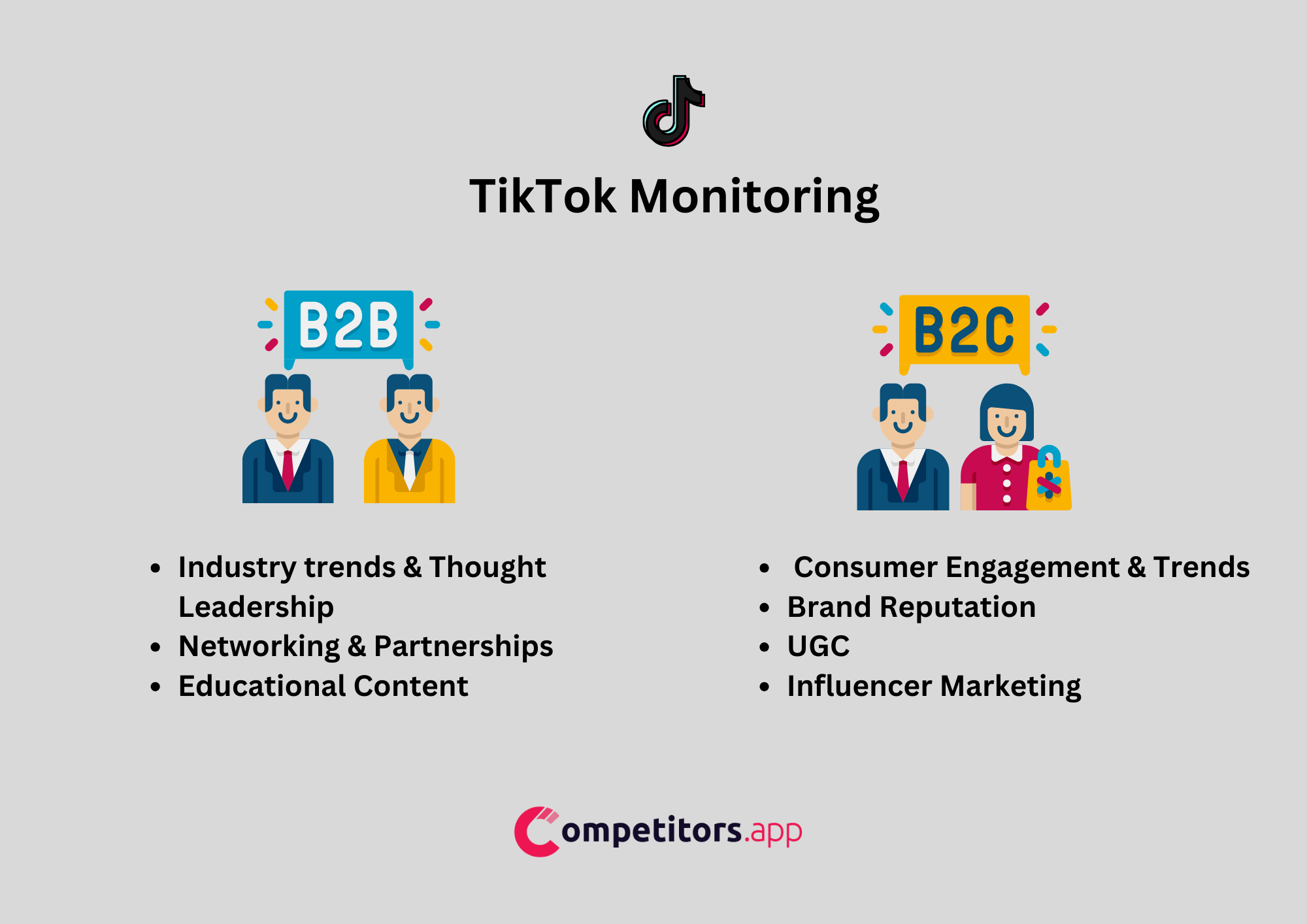
TikTok monitoring strategies can vary significantly between Business-to-Business (B2B) and Business-to-Consumer (B2C) models, as they often have different objectives and target audiences.
After effectively monitoring and analysing your TikTok activities, the next crucial step is to turn these insights into actionable strategies. Here’s how to apply what you’ve learned:
1. Content Strategy Refinement: Use the insights from your monitoring efforts to refine your content strategy. If certain types of content are performing well, focus on creating more of that content. Conversely, if some content types aren’t resonating, consider phasing them out.
2. Audience Engagement: Tailor your engagement strategies based on audience feedback. If your audience responds well to a particular style of communication or certain types of content, make them a regular part of your TikTok presence.
3. Campaign Adjustments: Analyse the performance of your marketing campaigns on TikTok. Use this data to make informed decisions about future campaigns, optimising them for better engagement and conversion.
4. Respond to Trends and Sentiment: If trend analysis and sentiment monitoring reveal emerging patterns or shifts in audience preferences, adjust your approach accordingly. This could mean jumping on a new trend or addressing any negative sentiment head-on.
5. Competitive Strategy: Use insights from competitor monitoring to differentiate your brand. Find gaps in their strategies that you can exploit or learn from their successes to enhance your own approach.
6. Resource Allocation: Based on the performance metrics and ROI of your TikTok activities, decide where to allocate or adjust resources for maximum effectiveness.
7. Continuous Learning and Adapting: Social media landscapes, especially TikTok, are constantly evolving. Regularly review your strategies and be flexible to adapt to new changes or insights.
By turning insights into action, you ensure that your TikTok strategy is not only data-driven but also continually evolving to meet the demands of the dynamic TikTok ecosystem.
Yes, there are several apps specifically designed for TikTok monitoring. These apps provide analytics and insights into various aspects of your TikTok account, such as engagement rates, follower growth, and content performance. Some popular examples include Brand24, Storyclash, and Competitors.app.
The "best" tool can vary depending on your specific needs. Brand24 is great for comprehensive analytics and sentiment analysis, Storyclash excels in tracking social media trends and hashtag performance, while Competitors.app is ideal for competitor analysis. Evaluate each tool based on your objectives, such as engagement tracking, competitive analysis, or content strategy development.
It's advisable to monitor TikTok regularly, ideally daily, especially if you're actively posting content. Regular monitoring helps you stay updated with audience engagement, track the performance of your posts, and keep an eye on emerging trends.
Social listening refers to the process of monitoring social media channels for mentions of your brand, competitors, products, and any other relevant conversations. It involves analysing the information gathered to gain insights into brand perception, customer needs, and market trends.
Yes, you can use multiple social listening tools simultaneously. Each tool might offer unique features or insights, and using more than one can provide a more comprehensive understanding of your TikTok performance and audience sentiment.
Effective TikTok monitoring can significantly impact follower growth. By understanding what content resonates with your audience, adjusting your strategy based on performance analytics, and engaging with trends and user feedback, you can create more effective content strategies that attract and retain followers.
No, TikTok monitoring is beneficial for anyone looking to optimise their presence on the platform, including brands, businesses, content creators, and influencers. It's a valuable tool for understanding audience engagement, improving content strategy, and maintaining a competitive edge.